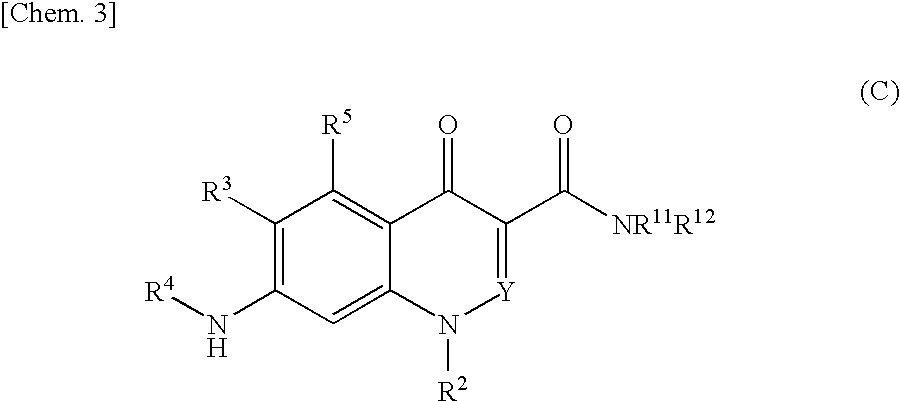Bicyclic heterocyclic compound
a bicyclic heterocyclic and compound technology, applied in the field of bicyclic heterocyclic compound, can solve the problems of acute coronary occlusion, clinical problems, and restenosis, and achieve the effect of excellent p2y12 inhibitory action
- Summary
- Abstract
- Description
- Claims
- Application Information
AI Technical Summary
Benefits of technology
Problems solved by technology
Method used
Image
Examples
production example 1
To a dichloromethane (9 ml) solution of 2,4,5-trifluorobenzamide (430 mg) was added oxalyl dichloride (0.3 ml) at 0° C., followed by stirring at 45° C. for 4 hours. The solvent was evaporated under reduced pressure, and dioxane (8.6 ml) and cyclopentylamine (0.3 ml) were added to the resulting residues and the mixture was stirred at room temperature for 12 hours. Water was added to the resulting reaction liquid, and the liquid was extracted with ethyl acetate, followed by washing with saturated brine. The liquid was dried over anhydrous sodium sulfate and the solvent was evaporated under reduced pressure to obtain residues. The residues were washed with a mixed solvent of ethyl acetate-hexane to obtain N-[cyclopentylamino)carbonyl]-2,4,5-trifluorobenzamide (370 mg).
production example 2
To a THF (220 ml) suspension of N-[(cyclopentylamino)carbonyl]-2,4,5-trifluorobenzamide (14.76 g) was added dropwise a toluene solution (217 ml) of 0.5 M potassium bis(trimethylsilyl)amide at −20° C. The temperature was raised to room temperature. After that, 1,4,7,10,13,16-hexaoxacyclooctadecane (2.75 g) was added to the mixture and the mixture was stirred at 100° C. for 8 hours. The resulting reaction liquid was added to a mixed solution of a 10% aqueous citrate solution (150 ml) and 1M hydrochloric acid (150 ml) under ice cooling and the liquid was extracted with ethyl acetate, followed by washing with water and saturated brine in this order. The liquid was dried over anhydrous sodium sulfate and the solvent was evaporated under reduced pressure to obtain residues. The residues were purified by silica gel column chromatography to obtain 9.19 g of 1-cyclopentyl-6,7-difluoroquinazoline-2,4(1H,3H)-dione.
production example 3
To a DMF (5 ml) solution of 1-cyclopentyl-6,7-difluoroquinazoline-2,4(1H,3H)-dione (320 mg) were added potassium carbonate (200 mg) and ethyl bromoacetate (0.15 ml), followed by stirring at 60° C. for 12 hours. Water was added to the resulting reaction liquid and insoluble materials were collected by filtration to obtain ethyl (1-cyclopentyl-6,7-difluoro-2,4-dioxo-1,4-dihydroquinazolin-3(2H)-yl)acetate (270 mg).
PUM
| Property | Measurement | Unit |
|---|---|---|
| temperature | aaaaa | aaaaa |
| temperature | aaaaa | aaaaa |
| pH | aaaaa | aaaaa |
Abstract
Description
Claims
Application Information
 Login to View More
Login to View More - R&D
- Intellectual Property
- Life Sciences
- Materials
- Tech Scout
- Unparalleled Data Quality
- Higher Quality Content
- 60% Fewer Hallucinations
Browse by: Latest US Patents, China's latest patents, Technical Efficacy Thesaurus, Application Domain, Technology Topic, Popular Technical Reports.
© 2025 PatSnap. All rights reserved.Legal|Privacy policy|Modern Slavery Act Transparency Statement|Sitemap|About US| Contact US: help@patsnap.com



